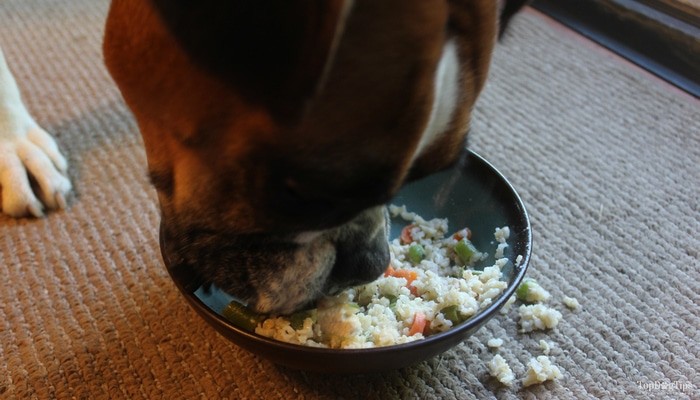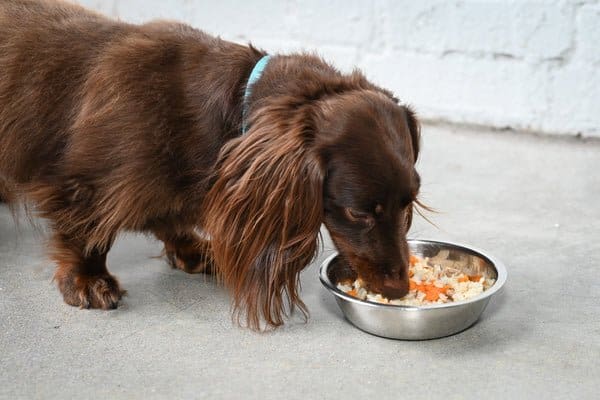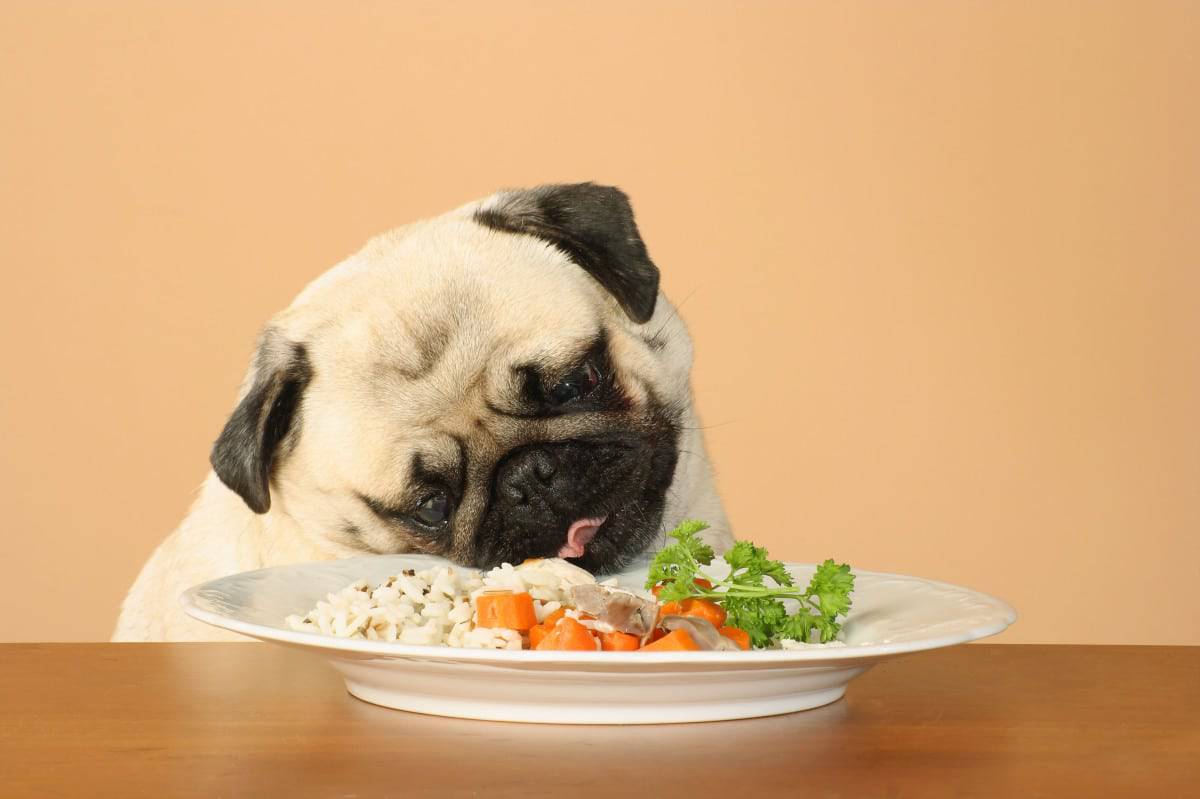A bland diet is a diet that is made up of highly digestible ingredients. The goal of a bland diet is to settle and soothe the digestive system when a dog is ill.
For instance, if your dog eats something that just doesn’t agree with their digestive system, or if they are suffering from some kind of intestinal bug, a bland diet will come in handy.
Dogs are surprisingly good at digesting almost any type of food. But every now and then, they might try something that affects them.
If this happens, a bland diet might be a good solution. In fact, bland diets are commonly prescribed by vets for dogs that have diarrhea or are vomiting.
How Does A Bland Diet Work?

A bland diet is just that – bland. It is made up of low fiber and low-fat ingredients that are extremely easy to digest.
The low fiber content in the diet slows down the process of producing stool. This means your pup will not feel the urge of going to the bathroom as frequently as they do when on a normal diet and this ultimately helps to ease their diarrhea problem.
Additionally, bland diets have low-fat content. The idea is for the diet to go easy on the stomach and this reduces vomiting.
Finally, bland diets are very easy to digest and this helps to reduce intestinal contraction (peristalsis). This gives your Dog’s GI tract some much-needed rest.
How Long Does It Take For A Bland Diet To Work On Dogs?
According to Lynn Buzhardt, DVM, it takes approximately 2-3 days for the bland diet to work on your dog.
After the third day, diarrhea, vomiting, or any other symptoms should have disappeared.
However, you can’t instantly resume the normal diet on the second or third day. It is best to introduce the diet gradually.
After your dog has recovered, you can start weaning them off the bland diet by mixing it with the normal diet in a 1:1 ratio.
As you do this, observe the tolerance level of your dog and then gradually keep increasing the quantity of the normal diet.
Ideally, the transition period should take approximately 5 days.
So, even though the bland diet will work on your dog in 2-3 days, you will still need an additional 5 days to transition them back to the normal diet.
What If Your Dog Doesn’t Recover Fast Enough?

A bland diet is not balanced, so your dog shouldn’t be kept on it for too long.
For a diet to be balanced, it needs to have all the minerals and vitamins a dog needs per day.
A bland diet, on the other hand, focuses on alleviating the health condition of your dog.
The goal of the bland diet should be to return your dog to his healthy self to allow them to start eating the normal diet again.
As such, bland diets should be a short-term solution because if your dog stays too long on the diet, he could suffer from nutritional deficiency.
Granted, there are some rare conditions where the dog may not recover as quickly as you had hoped.
In such scenarios, you will need to work with your vet to find a safe way of keeping them on the bland diet for longer. This may include adding supplements to the diet.
Important Things to Remember When Feeding Your Dog a Bland Diet

1. Use A Vet Certified Recipe
A bland diet is not just a diet – it is a medical remedy that is prescribed by vets.
As such, do not use a recipe that has not been vetted and certified by a qualified vet.
There are lots of cookbooks on the internet that you can easily download and some of them have even been written by vets.
But most of these cookbooks are outdated and will not provide your furry friend with the required nutrients.
A recent study found out that only 9/200 internet recipes achieved the nutritional requirements for your dog to benefit from the diet.
Most recipes will just give vague instructions and recipes that may not necessarily work for your dog.
Besides, the nutritional requirements of dogs are different depending on the breed, age, and exact sickness.
This is why it’s a good idea to work with a Board Certified Vet Nutritionist when developing a recipe for your dog.
2. Don’t Substitute Ingredients without Checking With Your Vet
After developing a bland recipe with your vet, there is a good chance you will run out of a given ingredient, or maybe you won’t even find it.
The ideal thing would be to replace it with something close but before you do it, make sure to check with your vet first.
According to a tufts study that was published in 2015, one of the hardest things for most pet owners was to stick to the recipe provided by their vets.
The study found out that most pet owners substitute the ingredients with their ingredients without consulting the vet and only 13% stick with the exact recipe to the end.
When you deviate from the ingredients, you put your pet at risk of imbalances and nutritional deficiencies which may make the problem worse.
3. Avoid Home-Cooked Bland Diets for Puppies, Pregnant or Nursing Dogs
A pregnant or nursing dog or puppies have huge nutritional requirements and failure to feed them the required nutrients can result in serious health issues.
Relying on home-cooked bland diets (even the commercially available ones that aren’t certified by a vet) is the easiest way to expose your pet to nutritional deficiency.
In fact, experts believe that most puppies that are grown on home-cooked diets suffer from some kind of nutritional deficiency.
When dealing with pets that have high nutritional requirements, the margins for error are too slim for you to rely on a DIY bland recipe.
Parting Thoughts
In summary, bland diets are given to dogs that have diarrhea, vomiting, or some type of intestinal bug.
The bland diets have low fiber and fat content and are therefore very easy to digest.
After 2-3 days, the bland diet should have worked its magic and your dog can slowly get back to their normal diet.
If this doesn’t happen, your vet can help you to customize the diet by introducing some supplements.
This way, your dog can stay on the diet for longer without the danger of dietary complications coming up.
Related Posts:
How Long Should I Keep My Dog On Chicken And Rice?
How Much Rice Should You Feed A Dog With Diarrhea?
How Much Pumpkin Should You Give a Dog For Constipation?
How Much Yogurt Should You Give a Dog With Diarrhea?
As an Amazon Associate, we may receive a small commission from qualifying purchases but at no extra cost to you. Learn more. Amazon and the Amazon logo are trademarks of Amazon.com, Inc, or its affiliates.

